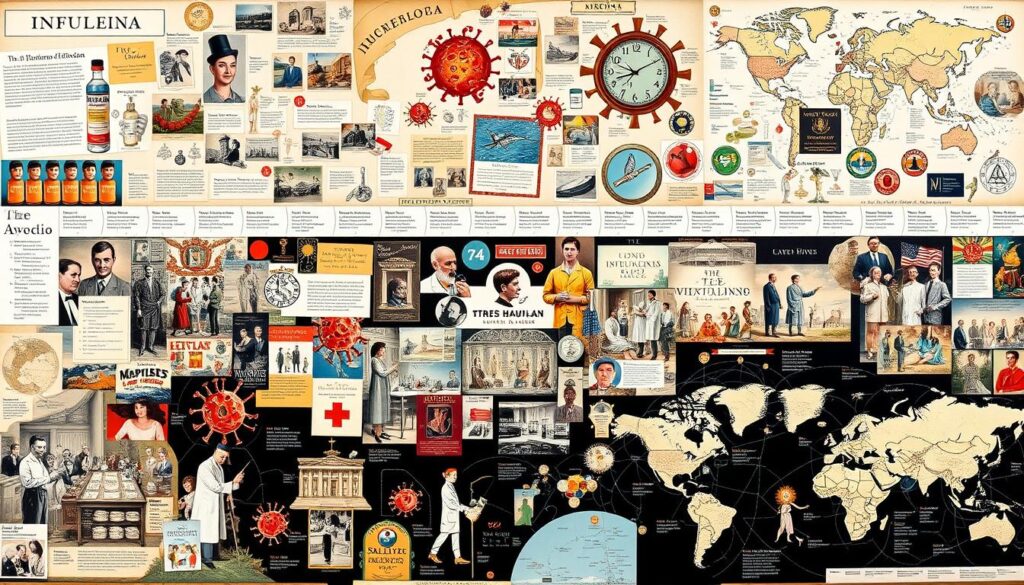Influenza has challenged human health throughout history. Flu vaccines have evolved to protect us from this dangerous respiratory illness. Medical science battles constantly mutating viruses in a complex struggle1.
The 1918 flu pandemic changed how we view infectious diseases. It infected about 500 million people worldwide, causing massive losses1. In the United States alone, over 550,000 deaths occurred during this time2.
Scientists have worked hard to create effective flu shots. Their efforts have greatly reduced seasonal influenza’s impact. Currently, up to 650,000 people die globally each year from the flu1.
Modern vaccines now prevent millions of illnesses and hospital stays annually2. Tracking pandemic flu events is now a top global health priority. Researchers constantly watch viral strains to develop adaptive vaccines1.
Key Takeaways
- Influenza has caused millions of deaths throughout history
- Vaccine development has significantly reduced flu-related health risks
- Scientific monitoring of flu viruses is ongoing
- Modern vaccines prevent millions of illnesses each year
- Understanding flu history helps improve prevention strategies
Early Understanding and Major Pandemic Events
Devastating flu outbreaks transformed medical understanding. Early research unraveled mysteries of notable flu epidemics. These efforts led to critical medical breakthroughs3.
The 1918 Spanish Flu Pandemic Impact
The 1918 Spanish Flu pandemic was catastrophic. It swept across the globe, causing unprecedented destruction4.
This pandemic killed about 40-50 million people worldwide. In the United States alone, over 550,000 deaths occurred4.
“In the face of unprecedented medical challenges, humanity’s resilience became our greatest weapon.”
First Scientific Breakthroughs
Medical researchers made big strides in understanding viral transmission. The 1930s saw the development of electron microscopy, revolutionizing virology5.
This tech advance let scientists see individual viral particles. It played a crucial role in influenza vaccination history3.
| Pandemic | Year | Strain | Estimated Deaths |
|---|---|---|---|
| Spanish Flu | 1918-1920 | H1N1 | 40-50 million |
| Asian Flu | 1957-1958 | H2N2 | 1-2 million |
| Hong Kong Flu | 1968-1970 | H3N2 | 500,000-2 million |
Early Vaccine Development Efforts
Developing an effective flu vaccine was challenging. In 1945, the first flu vaccine was licensed, marking a big milestone3.
Researchers found 18 H subtypes and 11 N subtypes of flu viruses. This created a complex landscape for vaccine development4.
- 1933: British researchers isolated the influenza virus
- 1942: Bivalent vaccine developed for H1N1 and influenza B
- 1948: World Health Organization established Worldwide Influenza Centre
Learning from past flu outbreaks helped medical pros create better strategies. These strategies aim to fight future epidemics more effectively4.
Flu History and Vaccine Timeline: From Military Use to Global Implementation
Influenza immunization has come a long way since its military beginnings. During World War II, researchers started developing specialized vaccines to combat infectious diseases. The first flu vaccine was approved for military use in 1945.
By 1946, the vaccine became available to civilians. Military medical teams were crucial in this development. Researchers like Maurice Hilleman discovered many viruses and created groundbreaking vaccines.
The adenovirus vaccine, created in 1956, showcased the military’s dedication to troop health. It helped prevent respiratory infections among soldiers.
“Vaccines are the most effective public health intervention in human history”
Global flu prevention efforts grew rapidly in the following years. Important milestones shaped the vaccine’s evolution.
- 1960: Recommendations for high-risk individual vaccinations
- 1970s: Pandemic prevention strategies developed
- 2002: Annual flu vaccinations recommended for young children
- 2010: Universal vaccination recommendations for all ages 6 months and older
| Decade | Flu Vaccine Milestone |
|---|---|
| 1940s | First military and civilian vaccines |
| 1960s | High-risk group recommendations |
| 2000s | Expanded vaccination coverage |
The ongoing evolution of flu vaccine development remains vital in protecting people worldwide. Military research and global teamwork have pushed influenza immunization forward67.
Conclusion
Modern flu prevention strategies are an ongoing scientific challenge. Seasonal influenza remains a serious global health threat. It causes up to 650,000 respiratory deaths annually89.
Understanding influenza research is key to grasping the complexity of fighting these viruses. Researchers are developing new ways to improve vaccine effectiveness. The future of flu vaccines is promising with recombinant DNA methods.
Live attenuated nasal spray vaccines are also advancing. These aim to boost protection rates beyond the current 40%–60%8. Scientists can create better vaccines by tracking viral mutations.
Vaccination is still the best tool for preventing influenza. It’s especially important for young children and elderly individuals9. Research focuses on understanding viral strains and developing stronger immunization strategies.
Your yearly vaccinations help reduce the impact of seasonal flu. The fight against influenza needs teamwork between researchers, doctors, and health organizations. Stay informed and proactive to help minimize this persistent viral threat.
FAQ
What is influenza and how does it spread?
What was the most significant flu pandemic in history?
When was the first flu vaccine developed?
How do flu vaccines work?
Who should get a flu vaccine?
How many types of influenza viruses exist?
How effective are modern flu vaccines?
What public health measures help prevent flu spread?
Source Links
- History of influenza vaccination – https://www.who.int/news-room/spotlight/history-of-vaccination/history-of-influenza-vaccination
- History of Flu (Influenza): Outbreaks and Vaccine Timeline – https://www.mayoclinic.org/diseases-conditions/history-disease-outbreaks-vaccine-timeline/flu
- History of Infectious Disease Outbreaks and Vaccines Timeline – https://www.mayoclinic.org/diseases-conditions/history-disease-outbreaks-vaccine-timeline
- Reviewing the History of Pandemic Influenza: Understanding Patterns of Emergence and Transmission – https://pmc.ncbi.nlm.nih.gov/articles/PMC5198166/
- Vaccine Timeline – https://historyofvaccines.org/history/vaccine-timeline/overview/
- A Brief History of Vaccination – https://www.who.int/news-room/spotlight/history-of-vaccination/a-brief-history-of-vaccination
- U.S. Military and Vaccine History – https://historyofvaccines.org/vaccines-101/how-are-vaccines-made/us-military-and-vaccine-history/
- Influenza vaccines: Past, present, and future – https://pmc.ncbi.nlm.nih.gov/articles/PMC8209895/
- Influenza ‑ Causes, Treatments & Pandemics – https://www.history.com/topics/inventions/flu
